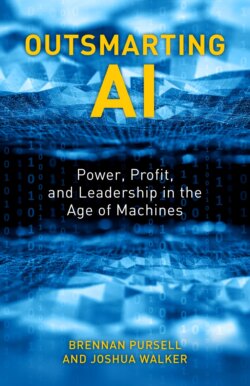Читать книгу Outsmarting AI - Brennan Pursell - Страница 11
На сайте Литреса книга снята с продажи.
Myth 1: AI Is a Robot
ОглавлениеAI and robots are not the same. AI is a family of data analytics procedures or algorithms performed by software run on hardware. Robots are contraptions equipped with sensors that produce digitized data, a central processing unit for that data, mechanical parts to complete tasks, and a power supply to run on. The robot’s data processor may or may not use AI algorithms.
The confusion is understandable. In journalism, stories about AI usually feature a picture of a robot or a digitized, humanoid face, probably because images of software, such as computer code or lots of 1s and 0s, are dead boring for most people.
Robots have caught people’s attention for millennia. From ancient Egyptian records, there are stories of statues of gods that gave advice or moved. In ancient Greece, there was a tale about a man made of bronze named Talos who guarded the island of Crete. Statues that come to life by one means or another are almost stock characters in fantasy literature. Little children everywhere love to imagine that their dolls, stuffed animals, and action figures are alive and interact with them. Big people don’t seem to want to give that one up too easily.
AI is not bound to any certain device. Many AI applications, perhaps most, process data with no input or output from any moving mechanism. AI in sales and marketing, HR, finance, customer support, education, legal, and government usually involves no robots at all. (Chatbots are another matter.) AI software, however, can be used to control virtually any hardware component that relies on data processing—from autonomous cars to automated welding arms to swarms of flying weapons, or whatever.
Robots can use AI in order to react to stimuli detected by their sensors and to adjust their motions or behavior accordingly. But AI doesn’t need a robot to make it worth your investment.
Even if AI is used to determine the actions of some robots, it does not attain anything close to human intelligence inside them, no matter how lifelike they may look or act. When you see a robot like “Eric,” “Kuri,” or “Jibo,” think “technologically animated plastic doll,” not “human replacement.” Saudi Arabia’s granting citizenship to a robot named “Sophia” was a publicity stunt. No robot, with or without AI, can guide itself according to human concepts of justice, equality, fairness, and equity, or cope with human unpredictability. Managers of the Henn-na hotel in Japan staffed it with more than 240 robots but then got rid of half of them. In trying to respond to the widely varied needs of individual customers, the robots made too much work for the humans.
Yes, robots have been developed for sex, and the company that makes them opened a robot brothel near New York, but was stopped in Houston. We have no more to write about this subject, but we have to point out the obvious: No robot can love. Nor can any AI system. As much as some people may adore them, robots will never love them back. AI guru Kai-Fu Lee seems to have needed a life-threatening bout with cancer to realize this truth.[2]
